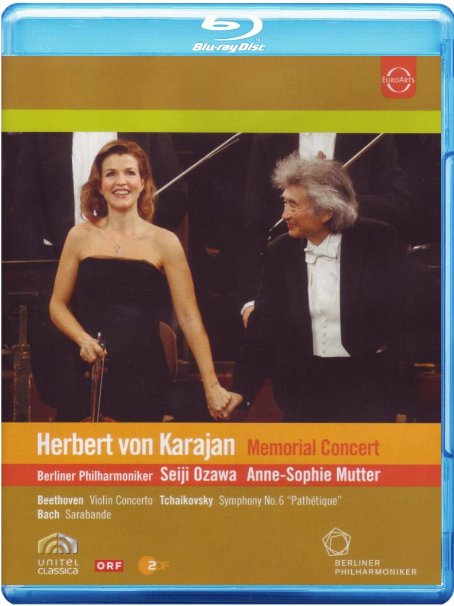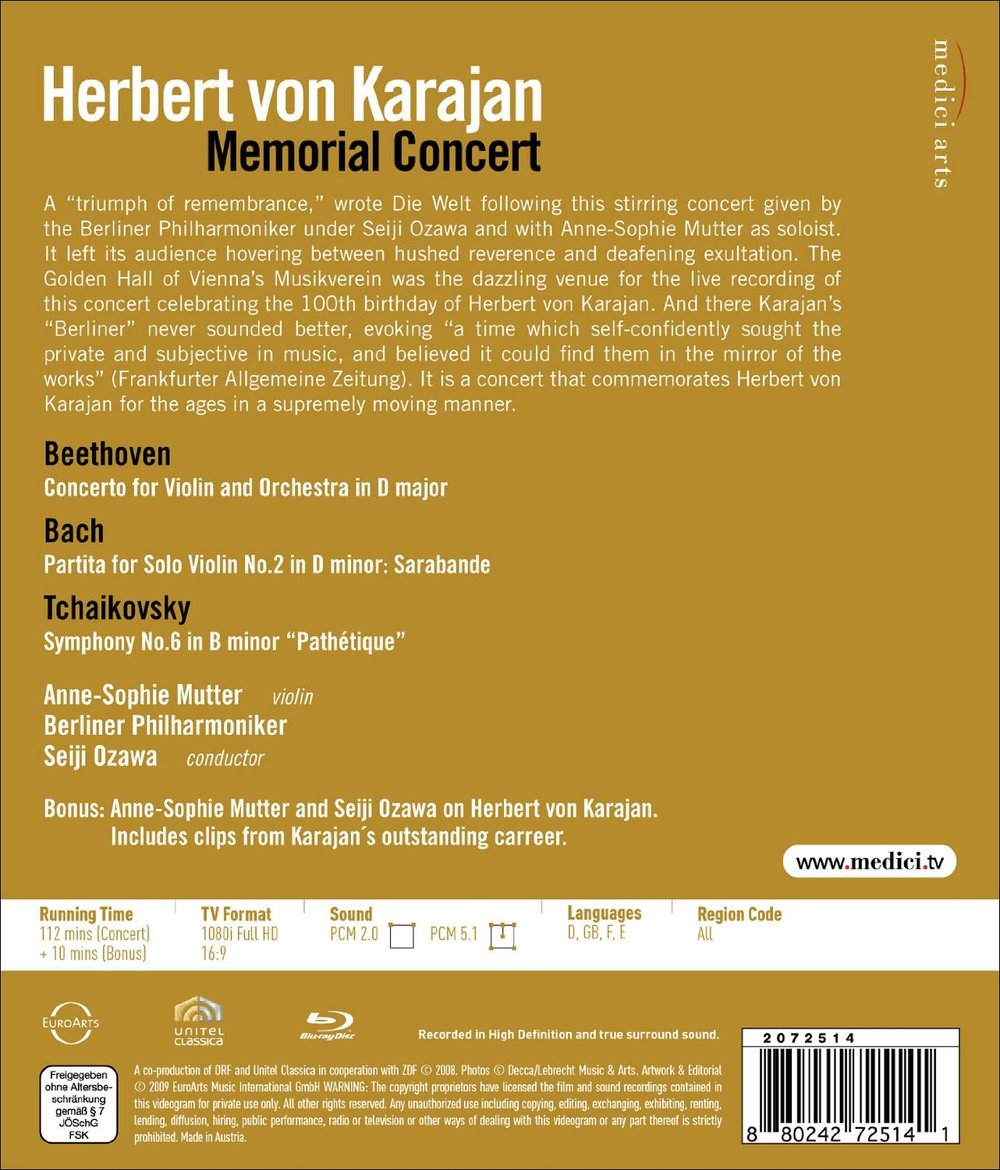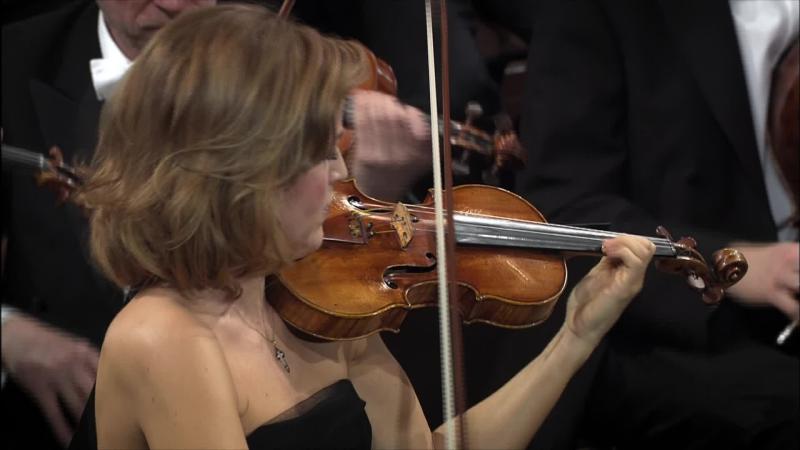

Beethoven Violin Concerto and Tchaikovsky Symphony No. 6—Herbert von Karajan Memorial Concert. Seiji Osawa conducts the Berlin Philharmonic in 2008 at the Großer Muzikvereinssaal in Vienna to celebrate the 100th anniversary of the birth of Herbert von Karajan. Here’s the program:
Anne-Sophie Mutter is soloist in the Beethoven Concerto for Violin and Orchestra
As encore, Mutter plays the Bach Partita for Solo Violin No. 2
Tchaikovsky Symphony No. 6 "Pathétique"
Directed for TV by Agnes Méth; director of photography was Alexander Stangl; video editing by Gernot Arendt; sound recording by Gregor Hornacek; sound editing by Florian Camerer; produced by Michael Heinzl. Released 2008, disc has 5.1 PCM sound. For Beethoven Grade: A- For Tchaikovsky Grade: B
Beethoven Concerto for Violin and Orchestra
When this disc first came out in 2009 both Wonk Gordon Smith and I were both swept away. Here's Gordon's review of Mutter's performance at the time:
“We have all enjoyed Beethoven's Violin Concerto many times live, on CD, and perhaps on TV or on DVD. But this performance, with all the glory of HDVD sound and vision, is a whole new experience! Not only does the Berlin Philharmonic play with the poise and ensemble of a chamber group, but Seiji Ozawa coaxes the most expressive phrasing out of them, surpassed only by Anne-Sophie Mutter herself.
And with Mutter's phrasing and expression, she brings a whole new reading and meaning to this war horse. HDVD makes the experience more immediate than ever before. The extreme close-ups of the violin and Mutter's finger work gives us a real "violinist's view" of the piece. You can't get this intimate relationship with the music and the process of playing it with a CD recording or even at a live performance! Well, maybe if you could come up with a ticket on the front row you could see Mutter about as well, but even then you would miss all the individual contributions from the orchestral players which are brought out so expertly in this video.
To see a work like this, with performers of this caliber, in such a way, is a unique privilege to savor again and again—which you can now do in your own home theater. This recording is a monument and a worthy tribute to Herbert Von Karajan. He was a pioneer of televised concerts. He would certainly admire this production.”
Since 2009, hundreds of symphony titles, including many violin concertos, have been published in Blu-ray. We have worked up standards for reviewing these recordings. We also have developed the Wonk Worksheet and Instructions for the Wonk Worksheet that you can find under our Special Stories. So it's time for an update. But before I get into statistics, let's enjoy some screenshots. Every Blu-ray recording of a symphony piece should start with whole orchestra (WO) shots to help the viewer see where the various musicians are located on the stage. Next below is a decent initial WO shot. By today's standards, the resolution is soft; fortunately, the Golden Hall has good risers to show off a symphony orchestra:
The next 3 shots below are what we call "realistic views" of the violin soloist:
You would have to have a front-center seat in the hall to have this view live. As long as the video image shows the waist and up of the violinist, we call this realistic:
The next view below is not realistic since nobody in the audience could see it. The Golden Hall is a cramped space and this inspires videographers to try a lot of shots from the rear and side:
This next view is also not realistic:
So what about this next shot below? Well, it's way to close to be seen by a member of the audience. But shots that clearly show the bowing and fingering of the violin have an irresistable appeal to viewers in the home theater. So we acknowlege these as "high-value" views and count them also as realistic:
So next below are two more realistic shots of bowing and fingering:
But the next two shots below are counted as "not-realistic" because they don't clearly show the bowing and fingering of the strings. There's nothing exactly wrong with showing some views like this, but we think they have less value than the frontal shots shown earlier:
Here's a nice part-orchestra (PO) shot made while Mutter rests. To get decent coverage of the orchestra, the videographer has to use side as well as front views:
And here's a fine shot of the almost-always neglected 2nd violins:
But the next view below has several glaring weaknesses. First, it's terribly framed as a shot of the orchestra because a head is in the way. Second, it's a desperately unrealistic shot of Mutter, who is busy playing now:
We count this stunt as "low-value." Videographers working in the small Golden Hall get bored and are tempted to try angles like this, but this is just distracting to the home viewer:
And Méth includes instrument-only shots, probably out of a desire to add variety. We think these shots generally are more distracting rather than informative:
Now I invite you to look at the Wonk Worksheet I made of this performance. Here's a report on the basic numbers for this video:
There are 48 minutes, 20 seconds of music divided into 379 video clips. This yields the (too rapid) pace of 7.7 seconds per clip.
Here's the clip breakdown:
Conductor shots = 17
Conductor-over-backs shots = 0
Soloist not realistic =77
*Soloist realistic = 92
Solo and other small-scale clips = 114
*Large-scale clips = 28
*Part-orchestra clips = 10
*Whole-orchestra clips = 16
Instrument-only clips = 22
Other low-value shots = 3
*Other high value=3
There are only 146 "supershots" (add up the * numbers above of 92+28+10+16). So the supershots are 38% of the total clips (146/379). Conductor shots total 17, and conductor shots use up 4% of the clips (17/379).
HDVDarts.com has established the following rules-of-thumb to identify a Blu-ray with DVDitis:
“A good symphony HDVD should have a slow pace with more than 10 seconds per video clip on average. 20 to 40% of the clips should be large-scale "supershots." Conductor shots should be less (way less really) than 20% of the clips in the video. When there is a star soloist, at least 50% of the soloist shots should be realistic.”
Subject concerto fails the pace test with the average clip running 7.7 seconds, substantially less than our 10 second standard. The supershot and conductor tests pass handsomely. But the test for realistic soloist shots passes just barely. So I diagnose a mild case of DVDitis. Méth could have made a better HD video by shooting fewer clips, staying with the good front shots longer, and avoiding instrument-only shots. (This could have also produced, I suspect, a better video for the DVD of this.) As explained in our special article on all this, DVDitis habits die hard.
Now for a grade. I start with A+. I have to drop to a B+ for DVDitis. By today’s standards, the SQ from 2009 is a bit harsh and "metallic." That gets me down to a B. But I'll have to admit I'm still a bit infatuated with Mutter for her performance of this concerto, which is, I guess, the most important music that exists for the violin. So I bump the grade back up to A-, which is a good grade on this website, especially for something that came out 9 years ago.
Tchaikovsky Symphony No. 6
Let's turn our attention now to the Tchaikovsky Symphony No. 6. This is a different performance from the NHK Pathétique played by Ozawa and the Berlin Philharmonic in 2008 in Berlin. Because we have two different performances of the same piece at about the same time with the same orchestra and conductor, we have a golden opportunity to compare the results from two different sets of technical operators. As good as subject title Symphony No. 6 is, it falls a level below the NHK performance. Subject title Symphony No. 6 suffers from some softness in resolution, color weakness, focus issue, and motion artifacts, especially in panning shots. It has too many short close-ups that do not seem logically related to what is being played, at least when compared to the NHK video in Berlin. The sound in Wein was recorded with normal sound sampling as opposed to the 96kHz/24 bit technology used by NHK. When you play the two discs back-to-back on the same HT gear, there's no doubt that the HNK recording is substantially better. As a result, the Berlin performance as recorded by NHK also seems substantially better. This is evidence that the industry needs now to start (1) making videos for HDVD only and (2) using 96kHz/24 bit sound recording technology whenever top sound is desired.
I'll conclude by giving the Tchaikovsky Symphony No. 6 on this Karajan Memorial Concert disc the grade of B. But for those used to records on CD and DVD, the recording on the Karajan disc is itself a huge step up. Most consumers looking for Tchaikovsky S6 would therefore opt for the Karajan Memorial Concert disc because you also get Mutter playing the Beethoven violin concerto. Stated differently, for most people, 2 hours of fine music at $35 is a better deal than 1 hour of audiophile music which costs maybe $70 (plus shipping from Japan). But if you are an audiophile, or a music professional with an interest in the state-of-the-art, or you have the money to always buy the best, then you should have both the Karajan Memorial Concert and the NHK disc of Tchaikovsky Symphony No. 6.
OR
















